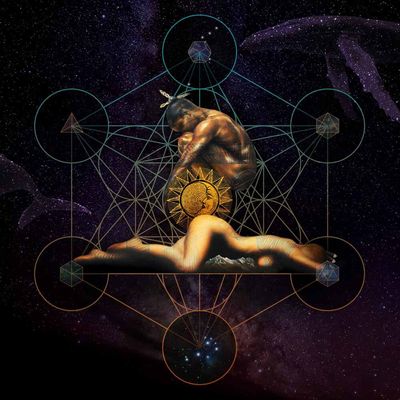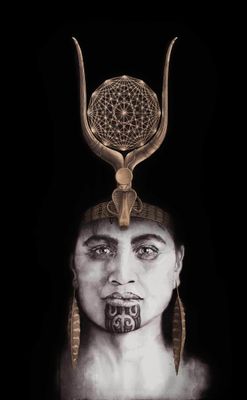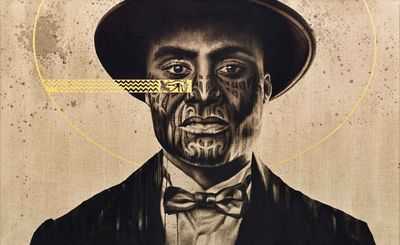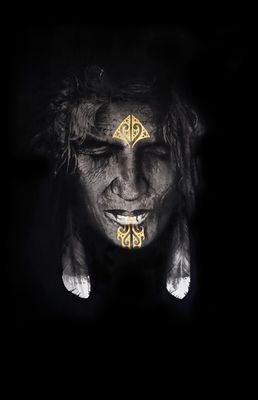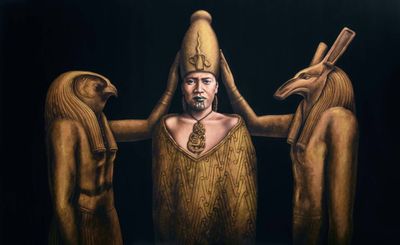
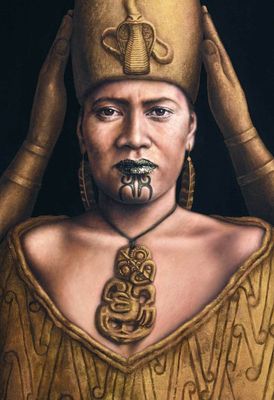
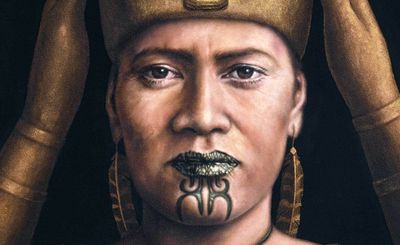
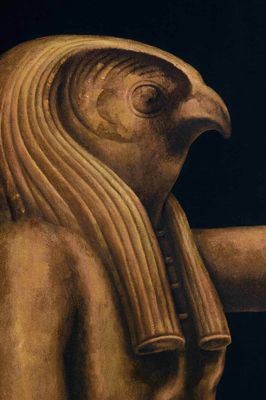


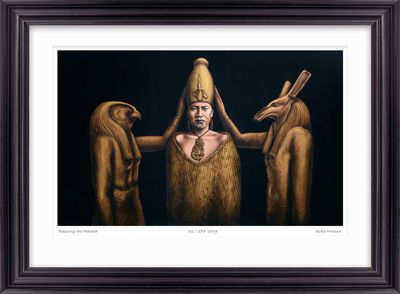
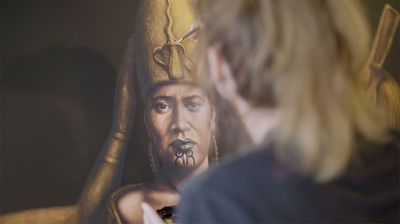
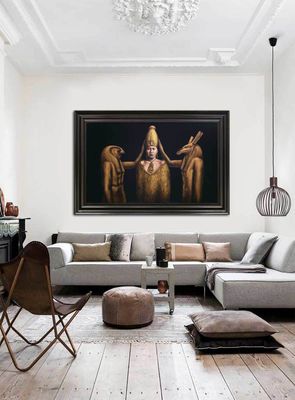
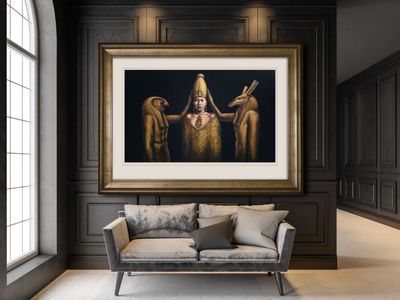

Blessing the Pharaoh
$950.00
Original painting SOLD, flashe (vinyl paint) on canvas, 1920 x 1290mm, 2019
Explore the story of the artwork >>
Print sizes and editions
- Regular museum archival paper print - 805 x 497mm (limited to 275)
- Large museum archival paper print - 712 x 1153mm (limited to 195)
- Extra Large museum canvas print - 840 x 1361mm (limited to 175)
Your unique limited edition fine art print
- Sofia creates your signed, museum archival print
- We ship for $25 in NZ and from $50 internationally
- Your artwork arrives rolled, ready to be framed - do you need help? Request framing guidance
The story of Blessing the Pharaoh
"He who looks outside dreams. He who looks inside awakens."
- Carl Jung
"Blessing the Pharaoh" is about the dawning of a new age that returns the sacred feminine back into harmony in our psyche. The painting reflects our human archetypal story of inner sight unifying left and right brain ways of thinking. The figures are based on the Egyptian statue in Cairo museum of the gods Horus and Seth blessing Ramesses III.
The link between cultures, gods and goddesses
I am drawn to the ever-unfolding wisdom and links between Māori and Egyptian myths, which demonstrate principles of nature in the form of gods and goddesses. Here we weave a new cross-cultural story, yet it is an eternally old one about the transformation of consciousness. With these symbols we pass the taonga (treasures) of ancestral knowledge onto future generations.
The central figure has my eyes and the facial features and moko kauae (chin tattoo) of my tupuna. She embodies atua wahine - divine feminine lunar energy. So too does the black background of Te Pō, which in Māori cosmology is the womb of potentiality. I see the wahine (woman) as Hine-nui-te-pō, the goddess of the threshold between life and death. She is our ancestral mother, akin to Egypt's Isis, who guides our souls through Rarohenga (the underworld). Her vow as she first entered the unknown realm of the deep was "maku e kapu i te toiora o a taua tamariki" meaning "I will secure the spiritual welfare of our children."
Balanced male and female energy
She wears a hei tiki pendant, which symbolises masculine solar energy, as does the shining metallic gold of the statue. Here I associate the carved golden tiki with Tāne, Hine-nui-te-pō's husband and the progenitor of humankind. When the goddess chose to descend to the underworld she told Tāne, who rules over the sun and all living beings, that he should stay and take care of their children in the world of light.
The V of her korowai (cloak) is the alchemical symbol for water and the feminine principle. Its presence at her heart centre with the hei tiki forms a union of yin and yang.
The composition is a negative space cypher of a human face. Eyes can be imagined on either side of the pharaoh's head with the third eye at the uraeus (rearing serpent) on the pharaoh's crown. The undulating serpent's tail is the vibration or tone coming from Source, through the crown chakra "singing" people into being.
Son of a king
Horus (pictured on the left) is the Egyptian falcon-headed god, son of Osiris and Isis.
Osiris was a great king who represented the state. Like all institutions he became old and willfully blind, refusing to see new dangers and adapting with the times. Osiris underestimated Set (pictured on the right), his brother, who was plotting to take the reigns of the kingdom. When Osiris wasn't paying attention, Set attacked the old king, chopping him into many pieces and distributing them all over Egypt. But Osiris can never be completely destroyed. The spirit of Osiris, which is culture and tradition, is in all the pieces.
Isis is the queen of the underworld. She found the phallus of Osiris and impregnated herself, giving birth to Horus.
Logic Vs Creativity
Horus has the crucial ability to see with perspective, like a falcon in flight. He is the son of the great mother and father - a messianic figure who parallels Christ. When he came of age, Horus decided to battle his uncle Set to get the kingdom back. He won, but in the process his left eye was ripped out.
Vital nervous energy from the left and right eye cross at the optic chiasm to the opposite hemisphere of the brain. Horus' left "lunar" eye therefore represents right brain, holistic, imaginative, archetypal consciousness. His right "solar" eye represents left brain, analytical thinking, tied with sensorial experience and contemplation of otherness. The loss of the lunar eye in the myth symbolizes a loss of holy, unified vision.
In his damaged state, Horus went down to the underworld. Thoth, representing cosmic wisdom, repaired his left lunar eye. He gave the eye to his father Osiris; the fractured, old, blind king. Together, they returned to the world, embodying the best of past and present. Horus is the concept of return, returning home or returning to the centre of self. Historically the pharaoh represented this Osiris and Horus partnership. The ruler must be awake to malevolence and revitalise the traditions of their ancestors.
Creating something new through conflict
Key to this myth is that although Horus defeated Set, he did not kill him. Instead, he reconciles with him. Set represents the vital principle of opposition. Without challenge, without polarity there is no frequency, no vibration that can be achieved, and therefore no manifestation, no creation. Before the painter makes their first mark, the blank canvas stares back at them in challenge. When a writer opens their laptop, Set defiantly blinks at them as the cursor on the screen, daring their creative will.
Finding equilibrium
Just as vertical, masculine, divine will is sacred, so too is horizontal, feminine, imagination and manifestation. We re-member ourselves on the cross of spirit and matter, perfectly balanced at the central seat of consciousness. Horus and Set, representing the principle of twoness, together bless the creation of the third, the new pharaoh or queen who represents unity. The alchemical image ushers in a new state of being where left brain logic does not rule over right brain holistic thinking, but a higher union of the two is established.
Sofia Minson Paintings | New Zealand Artwork
